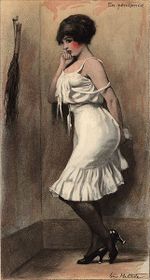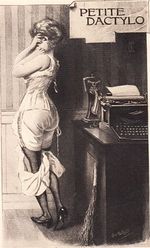Louis Malteste

Louis Malteste (1862-1928) was a french author and illustrator from the period of early 20th century French spanking literature. Among other genres, he is well known for his female spanking art and erotic flagellation drawings. He drew both adult and child spanking art to illustrate F/F and F/G spanking stories. Occasionally he also created M/G, M/B and M/F works. Among other techniques he worked in lithography and photogravure.
See also Malteste bibliography and/or Malteste gallery of works
Life
Malteste was born on 14 September 1862 in Chartres (Eure-et-Loir). He lived and worked in Paris, where he exhibited in 1897 at the Salon des Cent, and in 1902 at the Salon de la Société Nationale des Beaux-Arts. He worked for humorous publications, such as L'Assiette au beurre, Le Chat noir, Je sais tout, Lectures pour tous, and Qui lit rit, and created posters and postcards. ". He was also published in La Plume in 1897.[1]
Louis Malteste also used the pseudonym Ignotus, and under the pen name Jacques d'Icy, he wrote spanking novels such as Monsieur Paulette et ses épouses (1921) or Paulette Trahie (Paulette Betrayed, 1922). His first two books were entitled Qui aime bien (1912) and Châtie bien (1913). (Qui aime bien châtie bien - "Who loves well, punishes well" is a french proverb that roughly corresponds to the english Spare the rod and spoil the child).
Malteste died on 25 January 1928 in Paris.
Style
Malteste's style evolved with time and some of his works are extremely realistically drawn in terms of faces, proportions, light and shade, while other, mostly older works, are less realistic. Some of Malteste's works were obviously created based on photographs — for an example see the article creative tracing.
Malteste hardly ever used color but is a master of grey scale shading and texture.
See also
- Louise Malatesta (pen name of the spanking author Jacqueline Ophir)
- Douce_fille "Baby, Douce fille" on Biblio Curiosa (12 images)
- bien "Châtie bien" on Biblio Curiosa (5 images)
- "Lise" on Biblio Curiosa (4 images)
- préceptrice "Édith préceptrice" on Biblio Curiosa (4 images)
- Mains chéries "Les Mains chéries" on Biblio Curiosa (4 images)
External links
- Louis Malteste gallery on the Encyclopedia of Spanking Art
- Louis Malteste gallery with 27 images on Femdomart.ru
- Louis Malteste gallery with 14 images on Il Sottile Piacere
- "Baby.. douce fille" illustrations (11 images) on the Italian Spanking Art Pages
- "Quinze Ans" illustrations (10 images) on the Italian Spanking Art Pages
- "Miss" illustrations (7 images) on the Italian Spanking Art Pages
- A checklist of works illustrated by Louis Malteste on The Erotica Bibliophile (link fixed 08/2008)
- Louis Malteste - bio data (same artist?)
- Louis Malteste gallery with 21 images on Pin-upmania
- Paulette Trahie illustrations and sample Italian translation by Paul Stoves
- Louis Malteste on Vintage Visions
What links here • References and Sources • Help • Contact info

